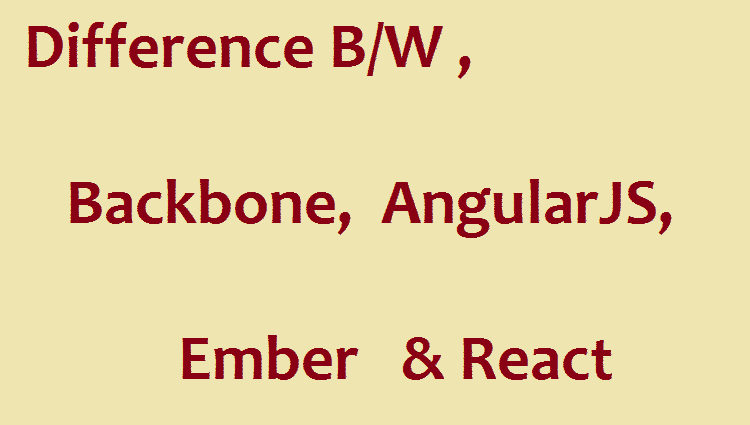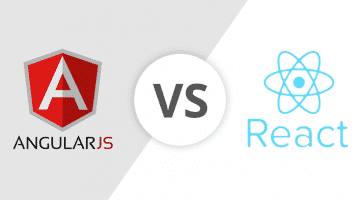Backbone, AngularJS, Ember, and React are all frameworks of one of the most popular programming languages of the present which is JavaScript. Whether you are a beginner or a JavaScript programmer, you should be confused as to which framework to choose and learn or program on for a particular application. For deciding that, you have to understand the differences between the frameworks at the basic level and understand their best applications. It is needless to say that AngularJS is the most popular among them. But that does not mean AngularJS is the only thing you should code or code in. The following is the pros and cons of each framework and you can make out the differences automatically.
AngularJS –
Positives – AngularJS is an open source framework that follows the MVC architecture as well as MVVM architecture. It is powered by Google, and it is the oldest of the four frameworks. Naturally, it is the most popular among them and has the largest community. Therefore, for a code as well as a learner’s perfective, AngularJS is in the sweet spot. It is best for developing single page applications. The development is quick due to code reusability feature, and you can do a straightforward UI design. Moreover, there is no need for two-way binding as it is clear from the second version of AngularJS. Furthermore, it is easy to test codes at any point, and it has dependency injection and robust template building solution.
Negatives – AngularJS is suitable and swift for static pages, but as soon as the pages start to interact with multiple elements and become dynamic, AngularJS slows down which is not good from the developer’s perspective. The third-party integration is still quite complex, and there are serious concerns about its performance. Therefore, AngularJS 2 is completely different from the original version which created a lot of controversies. It was not updated or redesigned, but it was rewritten completely. AngularJS 2 has come out recently, and you will find a steep learning curve. Even the older AngularJS programmers have become a learned due to the drastic changes in the latest version.
ReactJS –
Positives – In terms of popularity, ReactJS comes second. The interface design is easy, and so is the learning APIs. In terms of performance, it scores over AngularJS. Therefore, it updates in the backend can be reflected faster in the frontend. It is the best framework for debugging purpose. The best part is that it can work in sync with AngularJS and it is indirectly one of the reasons why it is in the picture of JavaScript frameworks. It has completely component-based architecture.
Negatives – It is not exactly a full-fledged framework. It is more of a library. The use of Flux architecture is not the wisest of decisions as not many developers are used to it in the current scenario. On top of that, it uses JSX to render components which is what the developers hate. The learning curve becomes steep and integrating with popular MVC frameworks needs a lot of configuration.
BackboneJS –
Positives – BackboneJS is slightly different in its approach as it follows the key-value binding model. The best thing about BackboneJS is that it is rich in APIs. It is more like a widget builder for creating blocks of HTML with JavaScript. The framework itself is super fast and lightweight. It actually provides a structure to your web application. The structures and concepts are very clear, and beginners find it a treat.
Negatives – It also allows 3rd-party templating, and there is no option for two way binding which many see as its con. However, one needs to use Marionette with for smooth development. The fact that the Views manipulate DOM directly is quite harder from development’s perspective. That is why BackboneJS is specifically not so popular among developers, and they prefer Ember over it.
EmberJS –
Positives – EmberJS comes with an inbuilt router which is the best among all the frameworks. The component model is better than AngularJS as it is simpler and the API is easy to understand execute.
Negatives – But somewhere down the line, it has a lot of similarities with AngularJS due to which it sometimes gets lost in the shuffle.
Parameter-Based Differences –
For dynamic UI binding, ReactJS has straightforward linking system followed by AngularJS which is slightly slow. For reusable components, EmberJS is the best due to its widget-based approach. It is followed by AngularJS and ReactJS. For routing, ReactJS is better though EmberJS is more powerful. It is complex in AngularJS. ReactJS has one-way data binding, the rest has two-way.
Final Words –
The popularity of AngularJS is still unharmed, but EmberJS poses a threat as most of the features are similar and there are some new features that can favor it in the long run. But the kind of revolutionary development AngularJS team is bringing, it does not look like any other framework can give it any competition in the near future.


